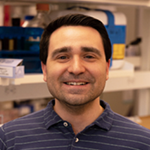APDA-Funded Research for 2025-2026
Exciting research is underway. Take a look at the innovative projects and inspiring researchers APDA is supporting this year.
George C. Cotzias Fellowship
The George C. Cotzias Fellowship is named in honor of the scientist who had a critical role in developing Levodopa as a treatment for Parkinson’s disease and is awarded with the purpose of encouraging young neurologists to follow in his footsteps.

Gaurav Chattree, MD
The Board of Trustees of the Leland Stanford Junior University
Developing Novel Therapeutic Strategies for Pathologic Circuits in Parkinson’s Disease
Pinpointing the specific types of brain cells that malfunction in Parkinson’s disease in order to guide new treatments

Krithi Irmady, MD, PhD
Rockefeller University, New York City, NY
RNA regulation in Parkinson’s disease and levodopa-induced dyskinesia
Investigating the RNA changes in the brain that lead to the development of levodopa induced dyskinesias

William Zeiger, MD, PhD
The Regents of the University of California, Los Angeles
Neuronal microcircuit mechanisms of posterior
cortical dysfunction and cognitive impairment in a mouse model of Parkinson’s disease
Studying how Parkinson’s disease affects brain circuits that support learning and memory to help better understand and treat cognitive symptoms
Diversity in Parkinson’s Disease Research Grant
The APDA Diversity in PD Research Grant is a one-year grant to study the health inequities and/or differences among under-studied PD communities, across the spectrum of ethnicity, ancestry, geography, socioeconomic conditions, and gender.

Michelle Fullard, MD
University of Colorado Denver, AMC and DC
Improving Shared Decision Making for Women with Parkinson’s Disease
Studying how a new decision support tool may help women become more informed and supported when deciding whether deep brain stimulation surgery is right for them
Social Science Research Grant
One-year grants to study social issues related to PD in the United States.

Tim Passmore, PhD
Oklahoma State University
Advanced Recreational Therapy Balance/Fall-Prevention Program for Individuals with Parkinson’s Disease in Small Cities
Development and evaluation of a structured home exercise program for people with PD
Post-Doctoral Fellowships
This fellowship is awarded to support post-doctoral scientists whose research holds promise to provide new insights into the pathophysiology, etiology, and treatment of PD.

Sammy Alhassen, PhD
The Regents of the University of California, Los Angeles
Circuit Mechanisms of Prefrontal Cognitive Impairments in Parkinson’s Disease Mouse Models
Studying how Parkinson’s disease affects brain circuits that support learning and memory to help better understand and treat cognitive symptoms

Michael Almeida, PhD
The University of North Carolina at Chapel Hill
The Role of CHIP Dysfunction in a-Synuclein Pathology: Mechanisms and Therapeutic Strategies for Parkinson’s Disease
Studying how CHIP, the brain’s ‘protein housekeeper,’ can help clear harmful clumps linked to Parkinson’s disease and open doors to better treatments

Nathan Baune, PhD
Emory University, Atlanta, GA
Electrophysiological characterization of neural circuit pathophysiology underlying freezing of gait
Characterizing the brain events that occur during freezing of gait

Julita Chlebowicz, PhD
Weill Medical College of Cornell University
Synaptic Vesicle Lipid Dyshomeostasis in Synucleinopathies
Studying fat Imbalances in Brain Cells to Discover New Treatment Targets for Parkinson’s Disease

Matthew Keeney, MD
Brigham and Women’s Hospital, Inc.
Dissecting the Impact of PD-relevant Stressors on RNA-binding Protein Biology in Tractable iPSC Synucleinopathy Models
The effects of Parkinson’s disease–related environmental stressors on alpha synuclein-mediated RNA processing

Nirmal Kumar, PhD
Rutgers, The State University of New Jersey
Synaptojanin-1 and VPS35 Interaction in Presynaptic Vulnerability
Studying how two Parkinson’s risk genes interact at brain cell connections, how their breakdown may cause early Parkinson’s damage, and testing a gene therapy to slow or stop this early damage in Parkinson’s disease

Yuxiao Ning, PhD
The Regents of the University of Minnesota, Twin Cities, MN
Multiregional neural population dynamics in
Parkinson’s disease and during directional deep brain stimulation
Comprehensively investigating the brain circuitry that is impaired in PD

Maria Olivero-Acosta, PhD
Yale University
Antisense Oligonucleotide Downregulation of Pathologic circRNA Profiles in SNCA Triplication Midbrain Organoid Models
Targeting Harmful circRNAs in Midbrain Organoids to Develop Precision Therapies for Parkinson’s Disease

Brianne Rogers, PhD
HudsonAlpha Institute for Biotechnology, Huntsville, AL
Mechanisms of SNCA regulation
Understanding how the alpha-synuclein gene is regulated

Carlos Soto-Faguás, PhD
Oregon Health & Science University, Portland, OR
The effects of the ApoE Christchurch variant on Lewy body pathology development and spreading
Understanding the effects of a newly discovered mutation in ApoE on the development of PD pathology

Donghe Yang, PhD
Memorial Sloan Kettering Cancer Center, New York City, NY
Characterizing and modeling the development of human A9 midbrain dopaminergic neurons with pluripotent stem cells
Generating dopamine neurons from stem cells

Letizia Zanetti, PhD
The Trustees of Columbia University in the City of New York
Investigating Neuroinflammation in a Novel PrknR275W Mouse Model of PD
Investigating the role of the immune system in juvenile, genetic Parkinsonism

Aryeh Zolin, MD, PhD
Weill Medical College of Cornell University
Trans-synaptic Propagation of Alpha-synuclein Aggerates in Vivo From Genetically Select Neural Populations
Determining how Parkinson’s disease pathology spreads between brain cells to develop ways to stop disease progression
Research Grants
This grant is awarded to investigators performing innovative PD research at major academic institutions across the United States.

Jessica Butts, PhD
William Marsh Rice University
Characterizing the Cellular Heterogeneity of the PPtg Using a Novel Marker – Spx
Identifying and characterizing the neurons that make up the PPTg, a critical area for PD symptoms, that is deep in the brainstem

Peter Chung, PhD
University of Southern California (USC)
Exploring the Role of Lipid Droplets in a-Synuclein Binding and Multimerization
Exploring how fat droplets may control a key Parkinson’s protein to reveal a future therapeutic target

Benjamin Clayton, PhD
Case Western Reserve University – School of Medicine
Modulating Pathological Astrocytes to Promote Neuroprotection in PD
Studying the response of crucial, non-neuronal cells called astrocytes, to pathological alpha-synuclein, with the goal of finding new approaches to treat Parkinson’s disease

Laura Cox, PhD
Brigham and Women’s Hospital, Inc.
Investigating Immunologic Mechanisms by which Alistipes Contributes to PD Pathogenesis
Understanding how bacteria in the digestive system contributes to developing and/or worsening of PD

Robert Heuermann, MD, PhD
Washington University School of Medicine in St. Louis
Pain as a Nonmotor Symptom in Parkinson’s Disease: Exploring the Role of the Amygdala
Studying why some people with Parkinson disease are more sensitive to pain, with the goal of finding better treatments.

Gary Ho, MD, PhD
Brigham and Women’s Hospital, Inc.
Palmitoylation of the Glucocerebrosidase Receptor LIMP2 and Regulation of Alpha-synuclein Homeostasis
Investigating how modifying the protein LIMP2, which regulates the Parkinson’s risk factor GBA1, can restore the normal state of the Parkinson’s protein alpha-synuclein.

Valery Krizhanovsky, PhD
Weizmann Institute of Science
The Role of Senescent Microglia in Parkinson’s Disease
Does removing or controlling aged brain immune cells reduce brain inflammation and PD pathology?

Zechuan Lin, PhD
Yale University
Translating GWAS Into Target Genes for Parkinson’s
Identifying Parkinson’s disease therapeutic targets by mapping gene regulation of dopaminergic neurons

Jonathan Lovell, PhD
The Research Foundation for The SUNY on behalf of University at Buffalo
a-Synuclein Active Immunotherapy With pS129 Nanoliposomes
Development of a vaccine strategy for the treatment of PD

Mariana Monje, MD, PhD
Northwestern University Feinberg School of Medicine
Elucidating GPNMB Endolysosomal Localization and Implications for Parkinson’s Disease
Investigating the role of the GPNMB protein in the developement of PD

Abby Olsen, MD, PhD
University of Pittsburgh
Validating Ak1 as a Therapeutic Target in a Mammalian PD Model
Studying a new Parkinson’s disease therapeutic target in mice

Abid Oueslati, PhD
Laval University (Université Laval, Québec)
Targeting Early-Stage a-Synuclein Aggregation for Parkinson’s Disease Therapeutics
Uncovering how toxic protein clumps first form in Parkinson’s disease to find new ways to stop the disease at its roots.

Darci Trader, PhD
The Regents of the University of California, Irvine
Degradation of a-Synuclein Oligomers via ByeTACs
Development of small molecules that help clear toxic alpha-synuclein accumulation

John Vaughen, PhD
The Regents of the University of California, San Francisco
Tracking GBA-dependent Lipids in Neurons and Glia Across Circadian Time
Studying where fats live in the brain across the day and night in Parkinson’s disease, to determine causes and identify strategies for fixing incorrect fat metabolism in disease
IN THE NEWS
APDA Awards $4.04 million in Research Grants.
